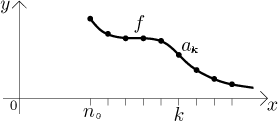
In a typical series, its terms ak are given by some
formula. Usually this formula makes sense not only for integers k
from the indexing range, but also for real numbers between them; that is,
the formula defines a function f on the interval

Is there any way to relate the behavior of such a series to the behavior of this function f? Under some circumstances it is possible.
Theorem (Integral test, IT).
Assume that f is a positive, non-increasing function on an interval[n0,∞) for some integer n0. For all integersk ≥ n0 defineak = f (k).
Then the seriesconverges if and only if the improper integral ak
converges.
Moreover, then we have
Why should something like this be true? The key observation is this: When we see a term ak of this series, we may interpret it as the area of a rectangle whose height is ak and the base is 1. This we can do with any number, of course, the real trick is finding a suitable rectangle to apply this idea to. We decide to use the above picture and place this particular rectangle is such a way that its upper left corner coincides with the dot marking ak. Then its base lies on the x-axis. We do this with all terms of the series.

Now look again at the rectangle associated with ak.
Since f is non-increasing and passes through the upper-left corner
of this rectangle, it follows that the integral of f between k
and
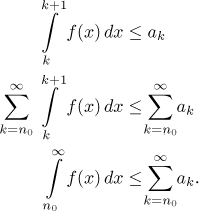
Thus we see that if the integral is divergent, that is, infinite, then the
series must also give infinity. Conversely, if the series converges, then the
integral must also converge (here we heavily use the fact that
It remains to establish the other direction, that is, an upper estimate for the series. This time we position our rectangles so that the points of the series are at their upper right corners. In this way the rectangle associated with an0 would go outside of f, so we will disregard it.
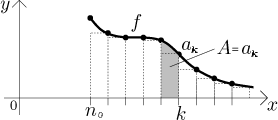
The area ak is now bounded from above by the integral of f from k − 1 to k.
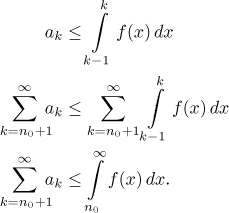
Now we just add an0 to both sides of this inequality and we get the desired estimate. We also see that if the series gives infinity, then the integral must be also infinite. On the other hand, if the integral converges, then taking into account that the series cannot run away from us to negative numbers we conclude that it must also converge.
Note that the last inequality in the calculation shows that we also have the following upper estimate for our sum:

Indeed, many authors (perhaps even most) actually put this upper estimate in their version of Integral test theorem, since it comes directly out of the proof. However, it never gives a better estimate than our version and in most cases it actually works worse, so we will not loose anything by ignoring it here.
Remark: In the theorem we used n0 as the starting
point for our indexing. However, if we are not interested in any estimate,
just in the fact of convergence or divergence, then we know that this
starting index becomes irrelevant. The integral test can be then simplified
like this: A series
Example:
We will prove now that the series
![]() converges.
converges.
The formula in the series also defines a function
Remark: We should actually remember the convergence of this series,
we usually refer to the
p-test, see Theory -
Introduction - Important examples. This p-test itself is proved by a
straightforward application of the Integral test. We simply replace 2 by
p in the above argument and then look at the convergence of the
integral (at infinity) of the function
A nice example of using the Integral test can be found in Methods Survey and others in Solved Problems - Testing convergence, namely this problem, see also this problem.
The two inequalities in the Integral test above allow us to also approximate the sum in case we are unable to find its precise value (which is the usual situation). Note that the difference between the lower and the upper estimate is exactly an0. We know that the terms of a convergent series must go to zero, which tells us that we get a more precise answer if we apply this estimate only to the tail of the given series. Look at the following example.
We proved above that the series
![]() converges. Now
we will try to estimate its sum when indexing starts from 1. Thanks to some
advanced theory we actually know what it is, see the appropriate example in
section
Important examples
in Theory - Introduction to series, but that result was obtained by a very
specific trick. Here we have a relatively low-tech method with much greater
potential for application.
converges. Now
we will try to estimate its sum when indexing starts from 1. Thanks to some
advanced theory we actually know what it is, see the appropriate example in
section
Important examples
in Theory - Introduction to series, but that result was obtained by a very
specific trick. Here we have a relatively low-tech method with much greater
potential for application.
According to the Integral test we have
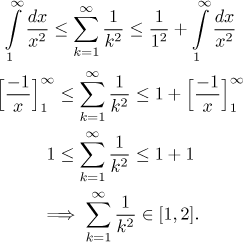
We have an estimate, but it is not too precise. Given that the result is
about 1, the error of 1 is way too large. Let's say that we would want to
have an error at most 0.005. Since the error is given by
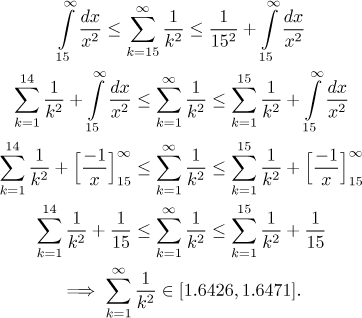
We might guess that the sum is about 1.645 and we will not be far off. The method that we used can be expressed in general by this formula:

The difference between the upper and lower bound is aK which for a convergent series goes to 0, so we get estimates of arbitrary precision just by taking sufficiently large integer K.